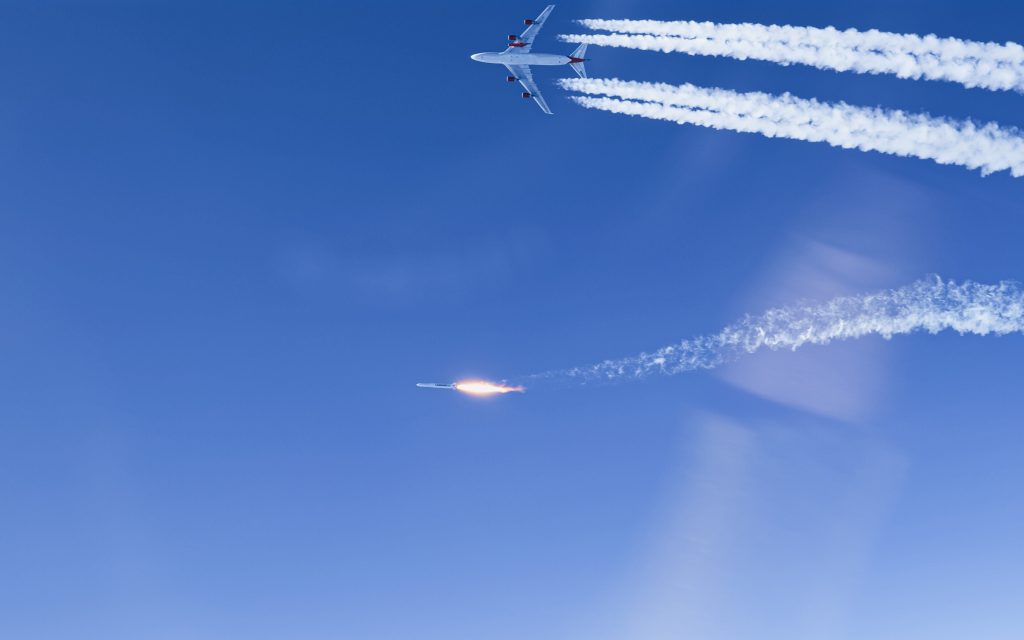
There is a new, demoed rocket in town. On January 17th, Virgin Orbit conducted their Launch Demo 2 mission of their LauncherOne rocket. The modified 747-400 Cosmic Girl lifted off from the Mojave Air and Spaceport in Southern California. It took off and headed south over the Pacific Ocean. Launcher One was dropped from the left wing of Cosmic Girl and climbed to orbit. Unlike the first mission, first stage burn, MECO, second stage burn, coast, and restart occurred nominally and Launcher One became the first air-launched liquid-fueled rocket to reach orbit.
Air launched orbital rockets are not new. The Orbital Sciences (now Northrop Grumman Innovation Systems) Pegasus rocket first flew in 1990, becoming the first privately developed orbital rocket of any kind. What makes Launcher One unique is the propellant. While it builds on the Pegasus design, Pegasus uses solid fuel on all 3 of its stages, while Launcher one uses liquid fuel on both stages, which allows it to more easily shut down its engines if it needs to. Basing the design on a Pegasus holds true to the pedigree of many of Virgin’s space vehicles. Burt Rutan, who designed SpaceShipOne and Two for Virgin Orbit’s sister company Virgin Galactic, also designed the wing on the Pegasus first stage.
Virgin Orbit originally planned to launch a dummy payload on flight 2, but after a lot of analysis and discussion with NASA, the decision was made to fly 10 CubeSats on the flight. This was under contract for NASA’s Venture Class Launch Systems (VCLS). These satellites are part of NASA’s Educational Launch of NanoSatellites (ELaNa) initiative, which is designed to attract and retain students in the science, technology, engineering, and mathematics disciplines. All were successfully deployed into orbit.
While we can’t talk about all ten of the satellites deployed by Launcher Demo 2, we do want to mention a couple of them.
The first is CACTUS-1, a 3U CubeSat from Capital Technology University in Laurel, Maryland. It will be carrying out two technology demonstrations: Project TRAPSat and Project HERMES.
Project TRAPSat is the main science component of the satellite, with a goal of trapping micrometeorites in an aerogel medium to better map the existence of micrometeorites orbiting the Earth.
Project HERMES will be the main communications component of the satellite flying under a different name – OSHComm. The Onboard Spacecraft Hotspot Communications Subsystem will communicate with the ground through satellite internet via the Iridium Constellation. This means that unlike conventional CubeSats, the communications coverage with the satellite will be global, 24/7, and accessible from anywhere with an Internet connection, allowing the CACTUS-1 team to command and receive data from their satellite from any computer, laptop, or smartphone at any time.
The other satellite we want to mention is TechEdSat-7, a collaborative engineering project between San Jose State University and the University of Idaho, with oversight from NASA Ames Research Center.
TechEdSat-7 is a technology demonstration mission that will further develop the Exo-Brake system by testing a High Packing Density Exo-Brake. In addition to Exo-Brake, it will demonstrate a CubeSat Identity Tag, or CUBIT, which is a DARPA RF-ID system that will aid in the identification of nanosatellites, including ones that have ceased to function.
More Information
Virgin Orbit press release
CACTUS-1 info page (Gunter’s Space Page)
TechEdSat-7 info page (Gunter’s Space Page)




 Join the Crew!
Join the Crew!
 Escape Velocity Space News
Escape Velocity Space News
0 Comments